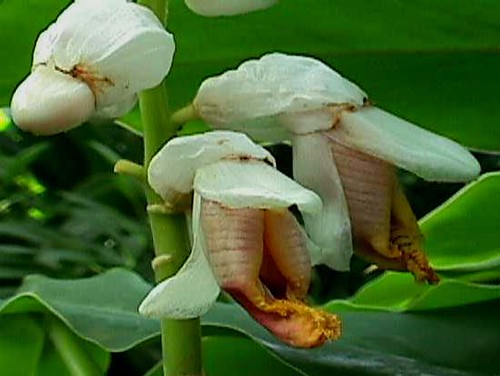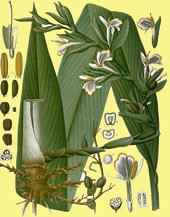 those of us who have a proper appreciation for that sacred beverage, qahwah, the bitter beans roasted to an oil-perfect finish and ground fine as flour just before le cafeterie get placed 'pon stoves or the steam machines gust and whistle into choochoolicious action, know also the secret of adding the spice. (on our left is a picture of the spice flower.)
those of us who have a proper appreciation for that sacred beverage, qahwah, the bitter beans roasted to an oil-perfect finish and ground fine as flour just before le cafeterie get placed 'pon stoves or the steam machines gust and whistle into choochoolicious action, know also the secret of adding the spice. (on our left is a picture of the spice flower.)
in fiction (dune), spice is disgorged by God (which we call شئ خلود [bless the Maker and all His works; bless the coming and going of Him; may His passing cleanse the world!]).
but in reality, the real spice is known vulgarly as cardamom and it is a highly valued commodity in arab lands.
cardamom comes from india - in fact, one of the words reliably attested in reconstructions of proto-dravidian is el- "cardamom" - and it is utterly divine.
In fact, cardamom coffee — al-qahwat al-'arabiyyah or al-qahwat al-hail in Arabic — is a nearly universal symbol of hospitality on the Arabian Peninsula. [...] Like many spices, it was used as a medicine well before it found culinary uses. The Ebers Papyrus, a pharmacological document dating from about 1550 BC, provides evidence that Egyptians were already using cardamom, as well as other spices, in medicines; they also used it in cosmetic ointments, perfumes and aromatic oils, for fumigation and for embalming.the above bits point both to cardamom's ancient popularity as well as to the ancient trade routes running from the middle east into distant meluhha (what is today pakistan-north india). enough trade ran those routes in this period - which predates the arrival of the aryans into persia and north india, when a flourishing civilisation of unknown provenance and speech communities - that vast quantities of copper made their way from mesopotamia in exchange for what apparently were even more massive quantities of foodstuffs, spices and the like. (you can read about the harappans and the indus valley cultures galore online if you like, but the point is that they offered the mighty spice cardamom in sufficient quantities for it to be available in egyptian markets.) the above article, which incidentally ran in saudi aramco magazine, explains its modern significance as well:In India, cardamom was sometimes prescribed, along with cinnamon, ginger and turmeric, to remove fat and cure jaundice and urinary infections. The Indian Ayurvedic system of medicine, based on the earliest Brahmanic texts, recommended that spices such as cardamom and cloves be wrapped in betel-nut leaves and chewed after meals to increase the flow of saliva, help digestion and eliminate bad breath, and millions of Indians do precisely that today.

In Saudi Arabia, however, cardamom enjoys almost universal popularity, and a well-prepared pot of Arab coffee — with praise for the generous quantities of cardamom in it — is a staple subject of traditional colloquial poetry in Arabia.and this, dear friends, is the secret - which i tell you to offset any displeasure at a certain pear blossom meme - : put cardamom in your coffee. that is, add it ground to your grinds before espressing them; be generous, and you shall enjoy great wisdom, pleasure and joy.During the period between Ramadan and the Hajj, the Muslim pilgrimage to Makkah, consumption increases as between one and two million Muslims enter the country as pilgrims, swelling the population during a three-month period. Throughout the kingdom, green coffee beans are lightly roasted, crushed with a mortar and pestle, or ground in an electric coffee mill, and boiled briefly with ground cardamom seeds.
If you order ready-ground cardamom coffee in a speciality store in Arabia, the clerk will add five or 10 grams of ground spice to 250 grams of coffee, but for special occasions, or to honor a guest with a particular display of generosity and good manners, quite large quantities of cardamom may be used. The spice gives the brew a greenish tint and a heady fragrance, and in some variations, it is the cardamom, and not the coffee, that is the dominant flavor.
also, your coffee breath will be much improved - this is perchance one of the finest effects of said spice, along with improved digestion.
i wish to end by noting that the scientific name of cardamom is elettaria cardamomum. and that, unfortunately, you will have to use some other spice to get high: it does not have the mind-altering effects of real mélange. *sigh*
2 comments:
adding five spice power and cardamom makes for a VERY tasty brew. it's like a liquid dessert.
you can. we've discovered than a standard espresso maker doesn't react well to a high percentage of cardamom and five spice though. the grinds get really sludgy and the espresso maker can't force the water through them. but a stove-top espresso maker would work i think.
cardamom and coffee grinds doesn't impair our espresso maker. i think it's the five spice that was too fine and sludgy for a normal espresso machine.
if you add honey and have a bit of dark chocolate with cardamom and five spice coffee, it's like visiting heaven's cafe.
Post a Comment